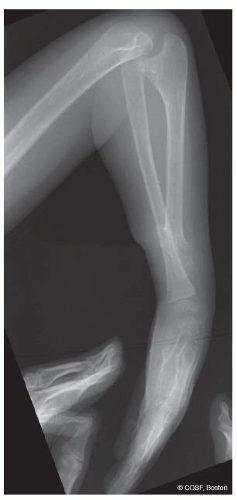E lesions begin as microchondromas within the periosteum adjacent to the normal physis, in the groove of Ranvier.A 4-year-old female presents with an osteochondroma (OCE) of the distal ulna, a foreshortened ulna relative to the radius, increased radial inclination of the articular surface, ulnar translocation of the carpus, ulnar deviation of the hand, proximal radial head dislocation, and reduced forearm rotation that has produced functional limitations (Figure 47-1).
CLINICAL QUESTIONS
What is the inheritance pattern of multiple hereditary exostoses (MHE)?
What are the gene mutations responsible for OCE formation?
What is the natural history of MHE?
What are the indications for surgical excision of an OCE?
Will excision of an OCE restore skeletal growth?
What are the expected outcomes from excision of an OCE?
When is an ulnar lengthening indicated?
When is creation of a single bone forearm indicated?
What are the complications associated with surgical reconstruction of an imbalanced forearm and wrist with osteochondromatosis?
What is the risk of malignant degeneration with an OCE?
THE FUNDAMENTALS
Etiology and Epidemiology
Arising from juxtaphyseal regions, OCEs are the most common (20% to 50%) type of bone tumor. The differential diagnosis includes metachondromatosis, dysplasia epiphysialis hemimelia (Trevor disease),1 multiple enchondromatosis (Ollier disease), and malignancies, among others. OCEs can either be solitary or multiple. Known also as multiple osteochondromatosis, multiple cartilaginous exostoses, and diaphyseal aclasis, among other synonyms, multiple hereditary exostosis (MHE) is typically (∽80% of cases) an autosomal dominantly inherited disease associated with mutations in tumor suppression genes (EXT1 and EXT2) that are required for heparan sulfate synthesis. Specifically, these EXT1 and EXT2 mutations lead to defective glycotransferases and altered endochondral ossification by abnormal chondrocyte proliferation and maturation.2 The OC0″ cellspacing=”0″>

FIGURE 47-1 Preoperative radiograph of upper arm and forearm of a 4-year-old child with distal ulnar OCE and a marked dislocation of the radial head.
Patients with MHE usually present earlier because their genetically aware parents will repeatedly examine their children for lesions. The severe EXT1 pedigrees will have lesions at younger ages, some present in infancy and even in flat bones such as ribs. Digital malalignment and a prominent finger mass arising from the phalangeal articular cartilage can occur in infancy with an EXT1 patient. The ratio of ulnar length to patient height has been used to distinguish EXT1 and EXT2 patients.9
Restricted and/or painful joint motion; long bone deformity; growth discrepancy of involved bones; joint subluxation; and impingement symptoms of neurovascular structures, muscles, and/or tendons are common complaints of patients with an OCE and MHE.10 The lesions wilonmouseover=”window.status=this.title; return true;” onmouseout=”window.status=”; return true;”>6 and 7 The EXT1 patients are also more at risk for malignant degeneration of an OCE lesion, as are patients with Maffucci syndrome (enchondromas and hemangiomas). The overall risk of malignant degeneration is about 2% for MHE patients.8 Sequencing differentiation of the EXT1 and EXT2 mutations in individual pedigrees is ongoing in many diverse ethnic families with MHE and will provide more definitive, patient-specific information in the future.
Clinical Evaluation
Patients with solitary OCEs usually present when the lesion is large enough to be palpated. This is often during
an accelerated growth phase, such as during the preadolescent growth spurt. The presence of a firm mass raises a serious concern over malignancy by parents, providers, and patients. The parental and patient worry about a possible cancer is often the “elephant in the room,” and addressing this grave concern of theirs promptly is a great relief to patients and families.
an accelerated growth phase, such as during the preadolescent growth spurt. The presence of a firm mass raises a serious concern over malignancy by parents, providers, and patients. The parental and patient worry about a possible cancer is often the “elephant in the room,” and addressing this grave concern of theirs promptly is a great relief to patients and families.









